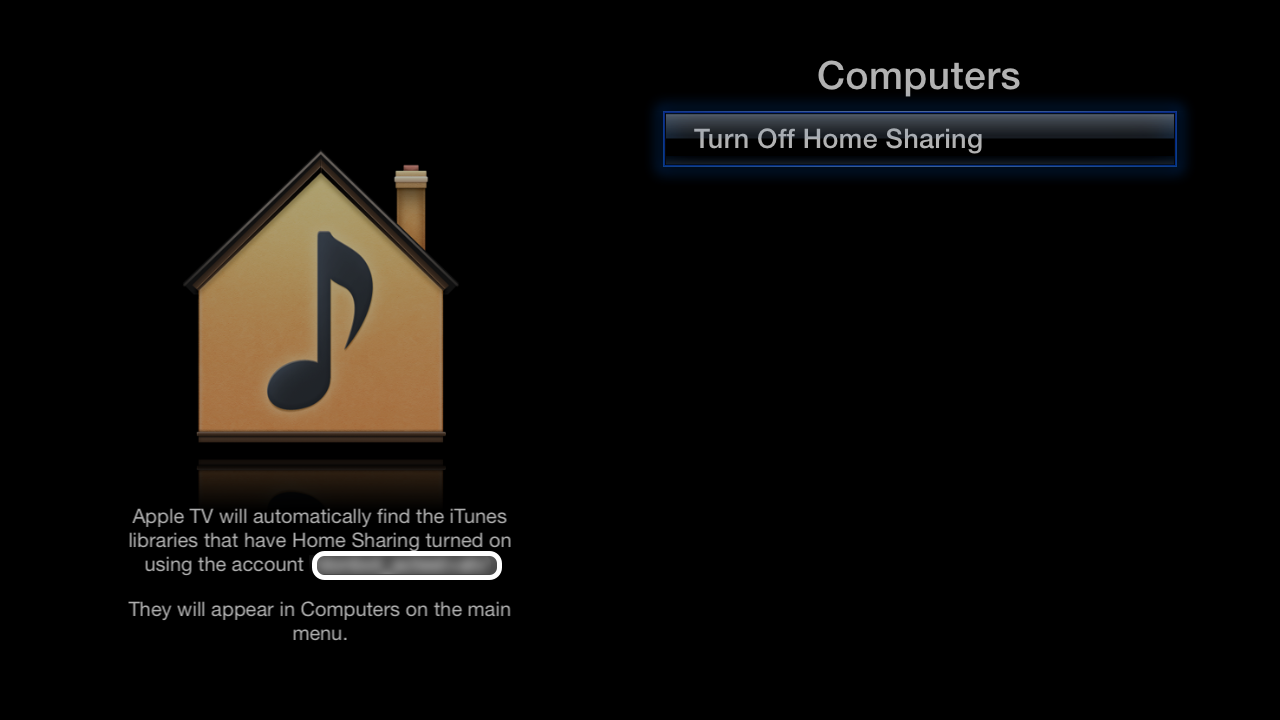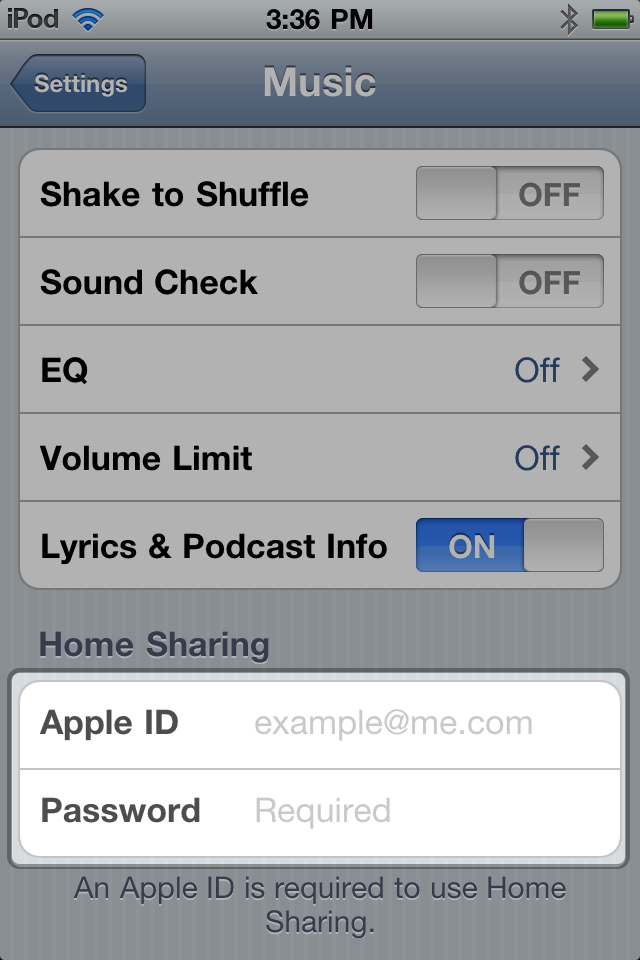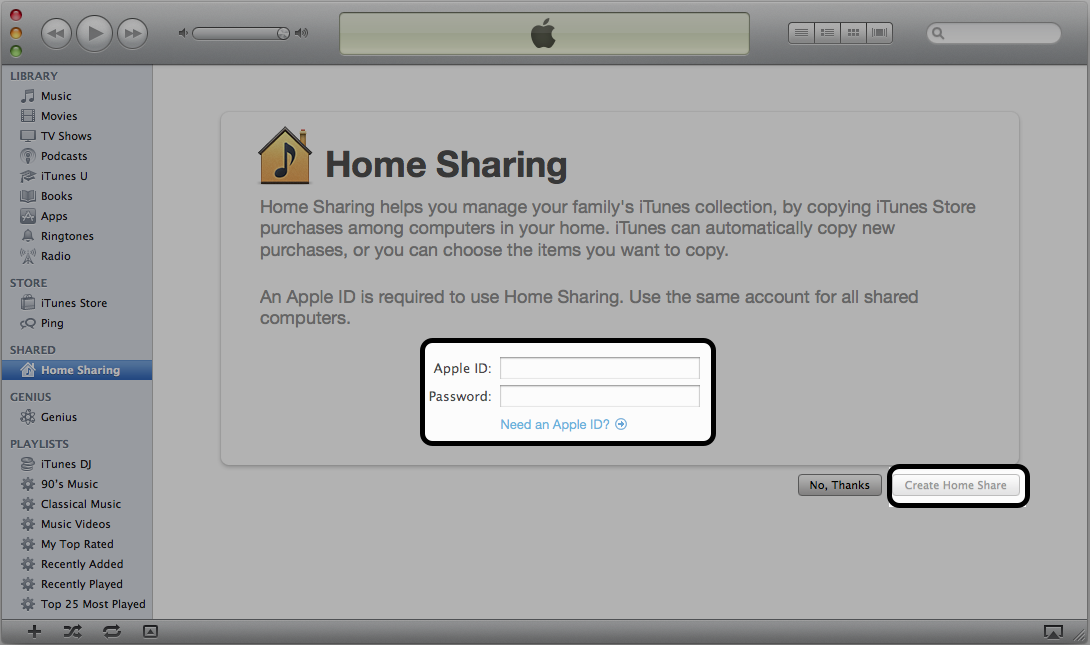Troubleshooting Home Sharing
Symptoms
Learn what you can do if, after setting up Home Sharing, you cannot access your shared iTunes library over your home network from another computer, Apple TV, or iOS device.
Note: For general information about Home Sharing, see Understanding Home Sharing.
Resolution
1. Set up Home Sharing on all devices
2. Verify system requirements
3. Check your Apple ID
Home Sharing requires all computers, iOS devices, and Apple TVs (2nd generation and 3rd generation) to use the same Apple ID.
To verify your intended Apple ID is enabled on all of your devices:
- On Apple TV, navigate to Settings > Computers and look in the bottom left.

- On your iPod touch, iPhone or iPad, navigate to Settings > Music.

- On your computer, open iTunes. Choose the Advanced menu and scroll down to the option to Turn off Home Sharing (Apple ID).

- If you don't have the option to "Turn off Home Sharing (Apple ID):"
- Choose Advanced > Turn on Home Sharing in iTunes.
- When prompted, enter the Apple ID you'd lke to use.
- Click Create Home Share.

A maximum of five computers can use Home Sharing at one time. If this limit has been reached and you want to add a new Home Share, deauthorize one or more computers by choosing Deauthorize Computer from the Store menu in iTunes. For more information about authorization and deauthorization, see About iTunes Store authorization and deauthorization.
4. Check your network connection
Home Sharing requires a home network with an active Internet connection. All the devices you want to use with Home Sharing need to be connected to your home network.
In addition, verify that:- All your devices are connected to the same router, if you have multiple routers. Using multiple routers may prevent discovery between these devices.
- Your devices are not using a Virtual Private Network (VPN), or that they are all on the same VPN. A VPN may isolate the device and cause connectivity disruptions.
- If you have a router set up with a guest network, make sure all devices are either connected to the guest network and devices on the guest network are allowed to communicate with each other, or switch all devices to the primary network on your router.
- If your computer is asleep or shutdown, or iTunes is closed, there's no access to the shared iTunes library. Wake up or start the computer and open iTunes to regain access to that library.
- Your router needs to be up-to-date. If you are using an AirPort or Time Capsule, read this article to find out more about firmware updates. If you are using a router from another manufacturer, contact the manufacturer to inquire about available updates.
5. Check Firewall Settings
If you have a firewall enabled in your router or computer, make sure that the firewall is not blocking communication between your computers. Home Sharing uses TCP port 3689 and UDP port 5353 to communicate with shared iTunes libraries.
In addition, Apple TV and Mac computers will use port 123 to set the time automatically. Incorrect date and time on either the computer or Apple TV can cause errors for Home Sharing and connections in general.
If you are unsure whether your router has a firewall or the required ports open, test additional devices or another network to help isolate the issue. If the devices tested work on another home network, it is your router or network configuration.
For Mac OS X, you don't have to edit the port addresses, but make sure the firewall in Apple () menu > System Preferences > Security > Firewall are not set to:
- Block all incoming connections
- Allow only essential services
If you use another security/firewall software on your computer or router, follow this article or contact the manufacturer or check the documentation on how to open TCP ports 123 and 3689 as well as UDP ports 123 and 5353.
6. Quit and reopen apps and iTunes
7. Restart your network router
Restart your home network router using the method recommended in documentation from the manufacturer. This may include disconnecting the power cord for thirty seconds or more.
Note: During this period, Internet services such as a VoIP-based phone will not work, and any additional routers may need to be reset in sequence.
8. Cannot access my library when my computer is asleep
In order for Apple TV to access your library while the host computer is asleep, "Wake for network access" must be turned on.
Open System Preferences > Energy Saver and check (enable) the "Wake for network access" option.
In addition, the network that the host computer and the Apple TV (2nd or 3rd generation) is connected to must support Wake on Demand feature. This works by partnering with a service running on your AirPort Base Station or Time Capsule called Bonjour Sleep Proxy.
Read more http://support.apple.com/kb/TS2972